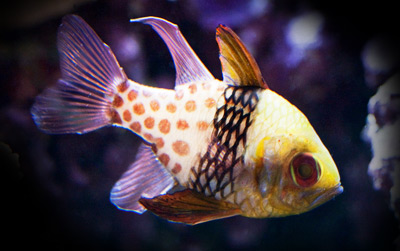A hardy, peaceful, wildly patterned species, the pajama cardinalfish (Sphaeramia nematoptera) makes a great choice for novice and experienced marine aquarists alike. Owing to its very manageable adult size, it’s a great candidate for modest-sized systems, and like many of the cardinalfishes, it can be kept successfully in groups.
Physical traits
In common with its other cardinalfish kin, S. nematoptera has two distinct dorsal fins, with the broader, transparent posterior dorsal trailing a long filament. Its maximum size is about 3 inches. With respect to color and patterning, S. nematoptera looks as though it were designed by committee. From the first dorsal fin forward through the head, this fish is golden yellow with a bright-red eye. From just behind the first dorsal through the caudal peduncle, it’s silver with reddish polka dots. A dark, vertical band appears at mid-body, dividing these two mismatched color schemes. The anterior dorsal and pectoral fins are yellow tinged with black and bordered with red.
Feeding
The pajama cardinalfish usually presents no special challenges when it comes to feeding. It will take most standard aquarium fare for carnivores, provided it’s suitably sized. Mysids, enriched brine shrimp, bloodworms, chopped clams and crustacean meat, pellets, and flakes are just a sampling of the foods this apogonid will accept.
Nocturnal by nature
Like all cardinals, S. nematoptera is a nocturnal species, so viewing opportunities might be best under lower-intensity lamps or, better yet, moonlighting after the main lights have been turned off. However, captive specimens often adapt to diurnal living when they realize that food usually appears during daylight hours.
Housing

As mentioned, S. nematoptera stays manageably small. That fact coupled with this species’ tendency to hover somewhat motionless in the water column makes a modest-sized aquarium very suitable. A tank in the vicinity of 30 to 40 gallons will suffice as minimum housing for a group of five.
In nature, pajama cardinals refuge among the branches of Porites spp. corals, so an aquarium that includes branching stony corals (or replicas of such) will make them feel right at home. And, yes, S. nematoptera will thrive in a reef aquarium with no harm done to the other inhabitants (with the possible exception of very small crustaceans).
Tankmates
A good-sized group of pajama cardinals hovering together in an aquarium is quite an impressive sight, so a good option is to keep S. nematoptera in a single-species tank with several others of its own kind. A hierarchy will develop in the group, but outright aggression among conspecifics will usually be minimal. Of course, these cardinals will also do well in a peaceful community, provided any tankmates are equally passive and disinclined to make a meal of bite-sized fish.
Breeding potential
Last but not least, S. nematoptera, a mouthbrooder, is among the best candidates for captive breeding in the home aquarium. So anyone contemplating such an endeavor might want to give this species a try.



